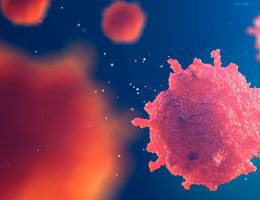Health library
Back to health libraryChronic leukemia: What to know

When you have cancer, it means that certain cells in your body have started growing out of control. With leukemia, the cells growing out of control are blood cells, most often white blood cells. White blood cells are manufactured in your bone marrow, and they help your body fight infection.
There are several types of leukemia, and they can be broken down into two broad groups: acute leukemia and chronic leukemia. This article will focus on chronic leukemia.
What are the symptoms?
Chronic leukemia is slow-growing. In fact, some people can have chronic leukemia for a while without knowing it because they don't have any symptoms. They might not find out they have leukemia until they have a blood test during a regular checkup.
When chronic leukemia does cause symptoms, they can include:
- Fatigue.
- Shortness of breath.
- Swollen lymph nodes.
- Frequent infections.
- Fever.
- Sweating.
- Weight loss.
The causes of chronic leukemia are rarely known. Although some things can raise your risk—such as genetics or exposure to certain chemicals—most people with leukemia don't have any risk factors, according to the American Academy of Family Physicians.
Two types of chronic leukemia
There are two main types of chronic leukemia: chronic lymphocytic leukemia (CLL) and chronic myeloid leukemia (CML).
- CLL begins in white blood cells called lymphocytes. CLL is the most common type of leukemia in adults, according to the American Cancer Society.
- CML starts in an early version of myeloid cells—the cells that make red blood cells, platelets and white blood cells (except lymphocytes). CML usually occurs in adults, but children can get it too.
In CLL, abnormal lymphocytes accumulate in the bone marrow but then go into the blood and spread to the lymph nodes, spleen and liver. Unlike regular white blood cells, these abnormal cells don't fight infection very well. That's why infection is one potential complication of CLL.
Another possible complication of CLL is anemia, which occurs when the body doesn't make enough red blood cells.
CML cells can block the development of red blood cells and other blood cells within the bone marrow. The abnormal cells can travel into the blood, spleen and other parts of the body.
How is chronic leukemia treated?
CLL may not require any treatment if it doesn't cause symptoms. Your doctor may suggest keeping a watchful eye on the disease with regular blood tests and physical exams.
If you have a more advanced form of the disease, your doctor may suggest one or more of the following treatments:
- Chemotherapy drugs to stop or stall the growth of the cancerous cells.
- Immunotherapy drugs, which kill CLL cells.
- Other oral medicines that disrupt the development of the cancerous cells.
For CML, the initial treatment is usually an oral medication that kills CML cells. If the disease relapses during treatment with the oral medication, stem cell transplants are often used. In stem cell transplantation, diseased bone marrow is replaced with healthy bone marrow donated by someone else.
If you're diagnosed with CML or CLL, ask your doctor about joining a clinical trial that's testing new treatments for the disease.
You can find information on acute leukemia here.
Reviewed 6/2/2025
